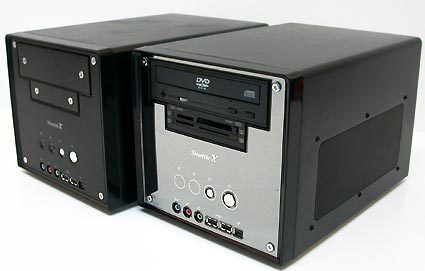No More Penny-Pinching: Seven Mini-PCs On The Catwalk
Trends 2004: High Quality, Mega-features And Performance In Compact Format
Analog and digital audio ports are standard on all mini-bare-bones: Pictured: 6-channel sound and optical SP/DIF out
Since the first mini-PC were introduced by Shuttle two years ago, much has changed. All bare-bones systems are becoming more sophisticated than ever, starting with their conceptual design - and the development continues. The current test panel shows very clearly that the so-called cube shape has caught on with all manufacturers. In terms of volume, most mini-PCs would take between 11 and 13 liters. A proper big tower, by comparison, would hold at least 65 liters. However, all manufacturers rely on their own boards with various layouts and thus with features that run the gamut. Still, the equipment - USB 2.0, FireWire (IEEE1394), 6-channel sound, network - sometimes even with 1 GB, digital input and output for sound (optical too) - have become de rigueur. Both the AMD Athlon XP and the Intel P4 platforms have dual-memory interfaces for DDR400 as expected. But in terms of performance, the mini-PCs no longer differ from their voluminous desktop brothers. In individual cases, a mini-bare-bones can even be upgraded with two fast 7200 hard drives in RAID-0 setup, if the data transfer rates in single mode are no longer sufficient.
Case volume: Left, the Shuttle XPC with just under 11 liters, and right, the Biostar with somewhat more volume
Shuttle duo: Left, the SB75G2 and right, the SB61G2 Reflexion special model
Get Tom's Hardware's best news and in-depth reviews, straight to your inbox.
Current page: Trends 2004: High Quality, Mega-features And Performance In Compact Format
Prev Page Sales Figures: Shuttle Leads Next Page Trends 2004, Continued

